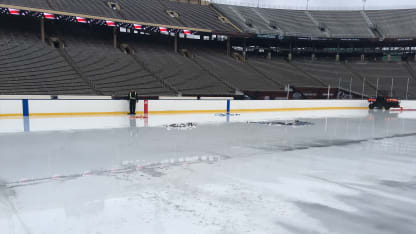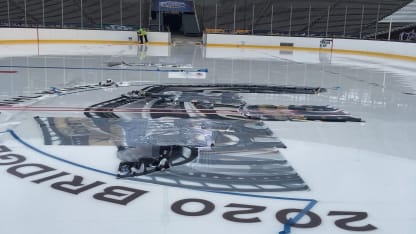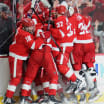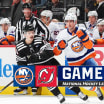King originally planned to have the ice ready the morning of Dec. 30, providing a buffer in case of bad weather. With rain and warm temperatures in the forecast, he moved up the schedule.
Crewmen painted the ice white Dec. 24 and laid the lines and logos Dec. 26, sealing them with layers of ice on overnight shifts when it was dark and cold. A typical NHL ice sheet is 1 inch to 1 1/2 inches thick. The goal here was 2 to 2 1/2 inches, so water could be removed instead of added if necessary.
When the crewmen came to build the ice Friday night, they faced warm temperatures, high humidity and wind. The ice was frozen where it met the aluminum floor, which transfers heat to the glycol pumped by the refrigeration truck outside. But it was melting from the top down.
All night into Saturday morning, they removed water while the refrigeration truck cranked 100 percent. They started to lose the white paint, they started to lose the lines and logos.
"And then the rain started, and just with how warm it was, the truck running, it got to the point where we now know we're going to lose everything," King said. "And then it just got worse throughout the day."
By 3 p.m., they had removed the lines and logos, which are fabric, not painted, and could be washed, dried and reinstalled.
At 3:30 p.m., it poured.
"That last rain was a killer," King said.
There was so much melted ice that the crewmen removed end boards so they had another opening through which to push water off the surface. They could not simply leave the water on the surface to refreeze it, because that would melt the ice underneath and threaten the entire sheet.
They made a plan for what to do after the rain stopped, breaking it down into four-hour windows, and got Cody Bateman, a crewmen who works for the Stars at American Airlines Center, to find more white paint.
At 5 p.m., the rain stopped. They had lost about 3/4 of an inch of ice, the equivalent of three days of work -- three days that included an overnight shift of Christmas Eve into Christmas morning for part of the crew.
"It was so deflating because there's nothing you can do," King said. "We couldn't bring another truck in. That wouldn't have helped. The guys were working as hard as they could. The truck was working as hard as it could. Just Mother Nature had other plans for us."



















